Olive oil is a staple in many kitchens around the world. It is not only a healthy cooking oil but also adds flavor to salads, dressings, and marinades. However, like any other food product, olive oil has a limited shelf life.
In this article, we will explore how long olive oil lasts, factors that affect its longevity, and signs of rancidity. Let’s dive in!.
Shelf Life of Olive Oil
The shelf life of olive oil can vary depending on factors such as its quality, storage conditions, and processing methods. Generally, olive oil can last between 18 months to 2 years from the date of bottling.
However, it’s important to note that this is an estimate and not an expiration date.
Factors Affecting Olive Oil’s Longevity
Several factors can impact the longevity of olive oil. Let’s take a look at some of the main ones:.
1. Quality of Olive Oil
The quality of olive oil plays a significant role in determining its shelf life. Extra virgin olive oil, which is made from the first pressing of olives, tends to have a shorter shelf life due to its high content of natural antioxidants.
On the other hand, refined olive oil, which undergoes further processing, has a longer shelf life.
2. Packaging
The type of packaging in which olive oil is stored can influence its longevity. It is recommended to choose bottles that are dark in color and made of opaque materials to protect the oil from light exposure, which can cause oxidation.
Additionally, airtight containers help prevent the oil from getting in contact with air, further extending its shelf life.
3. Storage Conditions
Proper storage conditions are crucial for maintaining the quality and freshness of olive oil. It is best to store olive oil in a cool, dark place away from direct sunlight, as exposure to heat and light can accelerate the oil’s degradation.
Additionally, fluctuations in temperature should be avoided, as they can negatively affect its stability.
4. Oxygen Exposure
Oxygen exposure is one of the major factors that can lead to the oxidation of olive oil. When exposed to air, the oil reacts with oxygen, causing it to become rancid.
Therefore, minimizing the oil’s exposure to oxygen by sealing the container tightly after each use is essential for preserving its freshness and flavor.
Signs of Rancidity
Knowing the signs of rancid olive oil is important to ensure you are using it when it is still safe and enjoyable. Here are some indicators of rancidity:.
1. Off Odor
One of the primary signs of rancid olive oil is an off odor. If the oil has a musty or rancid smell, it is an indication of spoilage. Fresh olive oil should have an inviting and aromatic scent.
2. Strange Taste
Rancid olive oil often has an unpleasant and bitter taste. It may leave an unpleasant aftertaste and can significantly alter the flavor of your dishes.
3. Changed Appearance
Visually inspecting olive oil can provide some clues about its freshness. If the oil appears cloudy, has sediment at the bottom of the container, or has developed an unusual color, it is likely rancid.
4. Lack of Health Benefits
Fresh olive oil is packed with beneficial nutrients and health-promoting compounds. However, rancid oil may have undergone degradation, leading to a reduction in its nutritional value and potential health benefits.
Conclusion
Olive oil can be a valuable addition to your culinary repertoire, but it is essential to keep an eye on its shelf life.
By considering factors such as the oil’s quality, packaging, storage conditions, and signs of rancidity, you can ensure you are using olive oil when it is fresh and at its best. So, check your pantry, follow proper storage practices, and enjoy the goodness of this versatile oil!.






























